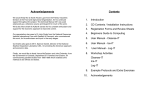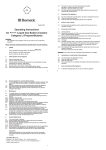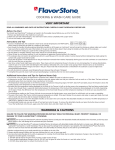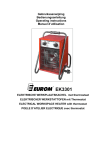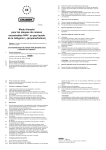Transcript
2.8. 3. Switching off the Appliance. 3.1. 3.2. 3.3. Turn the control knob to the off-position, (0-mark) to extinguish the burner. Close the cooker shut-off valve. Close the bottle valve during longer periods of non-operation. 4. Action in case of Faults 4.1. If a fault occurs the appliance must be switched off (see above) and a specialist consulted. 5. Correct Use of the Cooker English (GB) Operating Instructions for Liquid Gas Built-in-Cookers Category I3+ (Propane/Butane) 5.1. Cooking Utensils 5.1.1. Care should be taken that utensils are placed in the middle of the ring and that flames do not rise above the rims. 5.1.2. Utensils with misshapen/distorted bases must not be used . 5.1.3. The different burners on the cooking appliances can be equipped with pan supports of different diameter. The cooking untensils shall not have bigger diameters than the pan supports. 5.2. Air Supply 5.2.1. Ventilation openings with a cross section of at least 150 cm2 are essential in the room where the cooker operated during operation of the burner(s). These openings may be closable but must be open during operation of the burner(s). (See the instructions displayed above the cooker). 5.2.2. The combustion air supply pipes should be checked from time to time and cleaned if necessary. The burners must not be used as heaters. WARNING The installation of this appliance must only be carried out by an authorized specialist*. Please read these operating instructions carefully before using the appliance . 1. Validity These operating instructions apply to the following Built-in-Cookers in the EK2000 model range: EK-1101 to EK-1324, CE-1300 to CE-1464 WARNING: The burners must not be operated during refuelling or in garages. 2. Initial Operation of the Appliance 2.1. 2.2. 2.3. Open the gas-bottle valve. Open the cooker shut-off valve. Turn the control knob of the relevant burner from the off-position (0-mark), anticlockwise to maximum. (High flame). Push the knob in and hold it in this position. Ignite the burner with a match or other suitable ignition device. If the burner ignites the knob can be released after approximately 10 seconds. The knob may now be set to the required burner position. 2.4. 2.5. 2.6. 2.7. 5 7.2. 7.3. 7.4. 7.5. 7.6. Allow the appliance to cool down before cleaning. To avoid damage, the outer surface of the appliance should be cleaned using only a damp cloth without the addition of chemical or granular cleansing agents. The burner head(s) must not be dismantled when cleaning the appliance. Care must be taken that cleanser does not spill into the burner(s). After longer journies the appliance should be examined for any obvious damage or loose parts. 8. Maintenance 8.1. 8.7. For safety reasons it is essential that the appliance be examined annually by a specialist for fault-free operation and any faults eliminated. The following functions, in particular, should be checked during the annual service. Inspection of gas density. Inspection of burner safety and flame stability. Inspection of fresh air supply. Inspection of the safety and control fittings (burner taps). During every service the cooker box should be examined in correlation with the appliance and should be checked against the relevant regulations. If the flame openingsof the burnerheads becomdirty or blocked, they must be cleaned. The thermo-couplemust not be dirty and the correct distance between the burner head and the thermo-elementmust be maintained (ca 2-4 mm). The liquid gas supply system of appliances used in motorised vehicles should be tested by a specialist before initial operation and every two years thereafter, for tightness and function. A test conformance certificate should be issued by the specialist.* It is the user's responsibility to arrange these tests. Pressure loss should be checked during the test. 9. General Safety Advice 8.2. 8.2.1. 8.2.2. 8.2.3. 8.2.4. 8.3. 8.4. 8.5. 8.6. high flame = maximum position (depending from model: 2,0 kW; 1,6 kW or 1,0 kW) low flame = minimum position (ca. 0,5 kW) The entire ignition process should be clearly visible from above and not obstructed by cooking utensils. 9.1. 9.1.1. 9.1.2. 9.1.3. If the smell of gas is detected: Close the bottle valve and leave it closed until the fault is repaired. Open all windows and leave the room. Do not turn on any electrical equipment and avoid the use of naked flame, which could ignite the gas. 9.1.4. Consult a specialist.* 9.1.5. Under no circumstances attempt to find the leak with the aid of a naked flame. 9.2. Any alteration to the appliance can be dangerous and is not permitted. 9.3. Some parts of the appliance can become very hot: keep children away. *Specialists Expert gas specialists are those specialists whose training, knowledge and practical experience guarantee that they will carry out the inspection correctly. SR s.r.o. • Tehelná 8 • SK - 986 01 Fiľakovo • Telephone: 00421-47-82201 • • Telefax: 00421-47-82207 • 7 6 6. Instructions for Long Periods of Non-Operation 6.1. 6.2. 6.3. 6.4. Turn the knobs to the off-position (0-mark) Close the cooker shut-off valve. Close the bottle valve. After a long period of non-operation the appliance should be examined by a specialist.* 7. Care and Cleaning of the Appliance 7.1. A standard cleansing agent can be used to clean the appliance.
